Summer pulse agronomy including plant population row spacing varieties yields and nitrogen fixation
Take home message
- Reducing row spacing to 50cm and below will maximise summer pulse yields
- The improvement in yield is evident in differing environments and seasons
- Reducing row spacings may also increase the amount of nitrogen fixed
- Plant population has less influence on yield – continue with current recommendations
- Pulses should not be considered as only break crops but viable, profitable cropping options
Background and aims
Despite the potential environmental and economic benefits, the adoption of summer pulse crops in the Queensland Grains Region is around 4% of total cropping. To increase the share of pulses in the total cropping area, strategies are required to enable growers to more consistently realise the potential productivity and profitability of pulse cultivars in their farming systems.
One of the main aims of the project is to not only to get an increase in yields for summer (and winter) pulses, but to also improve the reliability of yields. When the risk in getting reliable yields in varied environments and seasons is reduced then pulses will not just be considered as a break crop in a cereal rotation or as an opportunistic cash crop but as a crop that can be considered a reliable and profitable part of the farming enterprise.
With mungbean yields averaging around 1t/ha in southern Queensland and a long term price of $750/t, an increase in yield of 10% could mean an extra return of $75/ha. Across a growing area of approx. 40,000ha this could mean an additional $3 million of returns to growers.
The Pulse Agronomy project has consulted widely within the pulse industry to determine the priorities to be investigated throughout the term of the project.
Mungbeans
Row spacing and population trials
The first summer pulse trials were established in the 2013/14 seasons and replicated again in 2014/15. The initial trials were based on a population trials with 3 varieties (Jade-AU, Crystal, and a pre release lines from the breeding program), planted at 10, 20, 30 and 40 plant/m2, on 50cm rows with 3 reps of each. In the first season 2 sites were planted at Warra and Dalby on the Darling Downs. In the season just gone 4 sites were planted, again at Warra and Dalby, with additional sites at Billa Billa and Miles.
Row spacing trials were planted with a target population of 25plants/m2. The row spacing treatments were 25, 50, 75 and 100cm in 2013/14 and 25, 50 and 100cm in 2014/15.
The comparison of the weather between the 2 years of trials is quite stark with 2013/14 being very hot and dry, while the 2014/15 season was relatively mild for a summer plant mungbean crop. Figure 1 depicts the weather for Warra over the 2 seasons with above average high temperatures and limited rainfall (55mm in 11 falls) in 13/14, while milder high temperatures and much more in crop rain lead to a doubling of yields at this site.

Figure 1. Comparison of 13/14 and 14/15 summers at Warra
In the 2 sites for 13/14 Jade-AU was the highest yielding variety across all row spacing treatments was Jade-AU, followed by the other commercial large seeded variety Crystal. The small seeded pre release variety MO9246 (since released as Celera II) was much quicker to flowering and maturity and prior to harvest a portion had shelled out of the pods, losses were estimated to be as high as 30% however the stated results are as harvested and not adjusted for loss.
a) Warra
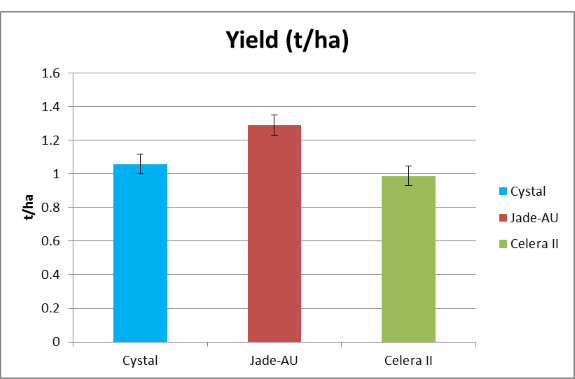
b) Dalby
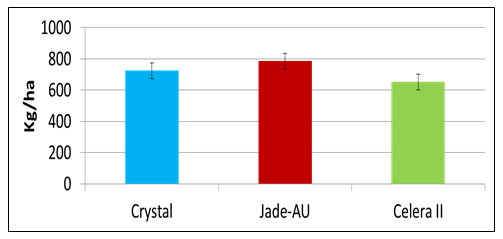
Figure 2. Variety grain yield for all row spacings at Warra (a) and Dalby (b) 2013/14
(LSD (5%) Warra: 0.119 t/ha Dalby: 101.2 kg/ha)
The highest yields at Warra were in the 25cm row spacing at 1.219t/ha, although this was not significantly better than the other row spacing treatment, with the lowest of 0.972t/ha for the 1m treatment.
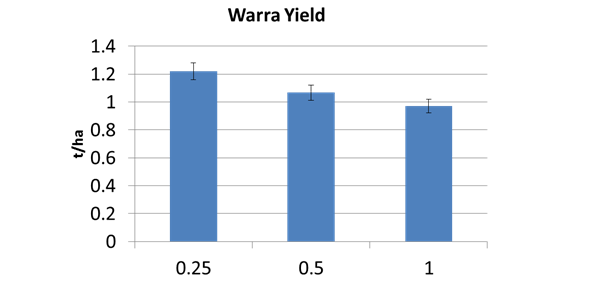
Figure 3. Warra row spacing yields for all varieties 2013/14 (LSD 5% 0.258)
The highest yield at Dalby in 2013/14 was from the 50cm row spacing treatment, but there was no significant difference between the 25cm and 50cm treatments, however there was a significant difference to 1m row spacing.
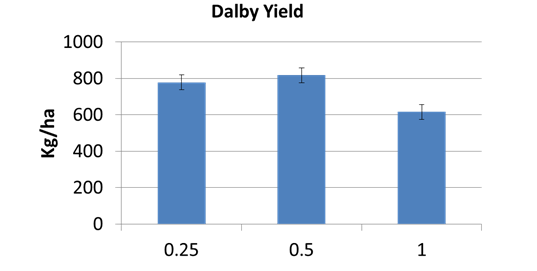
Figure 4. Dalby row spacing yields for all varieties 2013/14 (LSD 5% 81.6)
When the Warra row spacing by variety is graphed as in Figure 5, it can be seen that there is no effect of row spacing on the yield of Celera II. There is an effect on Crystal which is significant when row width is increased from 25cm to 50cm with a nearly 300kg/ha yield drop, with a further significant drop out to 1m rows.

Figure 5. Grain yield of mungbeans at Warra by variety and row spacing treatment (LSD 5% 370)
As the plot size is the same and the plants on different row spacings had access to the same volume of soil the differences in yield are due to the narrower rows being more efficient at converting soil moisture to grain as in Table 1.
Table 1. Water use efficiency (WUE) of row spacing treatments at Warra 2013/14(kg grain/mm) (LSD 5% 2.3)
|
Row space (m) |
0.25 |
0.5 |
1 |
|
WUE |
11.1 |
9.7 |
8.9 |
The 2014/15 results have not been fully analysed at the time of writing however some of the results from the Warra site have been included as a comparison to the much drier season before. In the much better weather conditions of 2014/15 yields were doubled that of the previous season.
The 2014/15 results have confirmed that Jade-AU has performed better than Crystal and 2 pre release lines (discussion limited to the commercial available varieties).
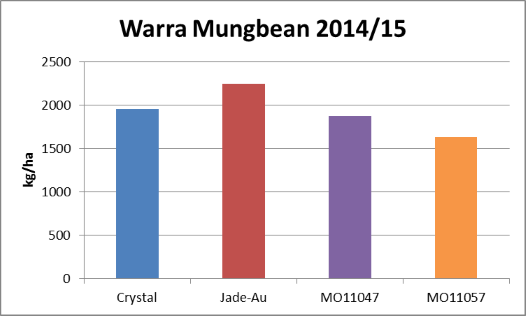
Figure 6. Warra 2014/15 mungbean variety yields, all row spacings (LSD 5% 562)
The yield differences between the varieties were not significant, there is significant difference between 0.25 and 0.5m and the 1m spacing. Crystal was the only variety that had not significant difference across row spacings, the other varieties all had lower grain yields at 1m.
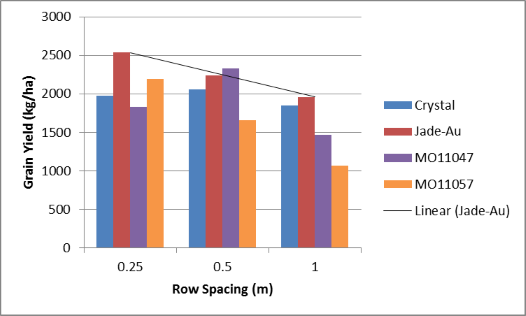
Figure 7. Warra 2014/15 mungbean grain yields variety x row spacing (LSD 5% 704)
In the first year there was no statistical difference in grain yield at the differing plant populations, however there was a trend for lower yields at 10 plants/m2 and a flat yield response in 20, 30 and 40 plants/m2. In the 2014/15 Warra results, which was a much higher yielding season, there appears to be yield increase in line with increases in the population across all varieties (not significant). This may suggest in high yielding environments that the target population should be above the current recommendation of 30 plants/m2.

Figure 8. Warra 2014/15 plant population yields (LSD 5% 318)
Mungbean nitrogen fixation
It has been shown that agronomic practices can influence the amount of nitrogen fixed by pulse crops. The 2013/14 mungbean trial at Dalby was sampled for number of nodules per plant, nitrogen in dry matter and grain and the proportion of that nitrogen that was derived from the atmosphere (%Ndfa). The site had an inherently high nitrogen of 150kg/ha and this in conjunction with the low yields at the site limited the amount of nodules to less than 1 per plant when sampled and the %Ndfa figures also showed that the amount of nitrogen in the plant from fixation by rhizobia varied from less than 9% to 16% with no distinct trends due to changes in row spacings.
This is in contrast to previous work at Kingaroy in the 2012/13 season. In this trial differences in the amount of nitrogen fixed was evident between varieties and the row spacings across all varieties (Figure 9).

Figure 9. Differences in total shot and root nitrogen by variety and row spacing, Kingaroy 2012/13
The differences in the amount of N in the shoots and roots (Figure 9) can be influenced by the amount of total dry matter produced or the %Ndfa. It can be seen in Figure 10 that the amount of nitrogen derived from the atmosphere for Crystal and Jade-AU was different with changes in row spacings, however Satin II kept the amount of N from the atmosphere constant at the varying row spacings.
As we have shown with the other trial results narrower rows are producing higher yields which must be supported by higher dry matter production. The crop then has a higher nitrogen demand that is being met by an increase in the nitrogen fixed by rhizobia and provided to the plant.
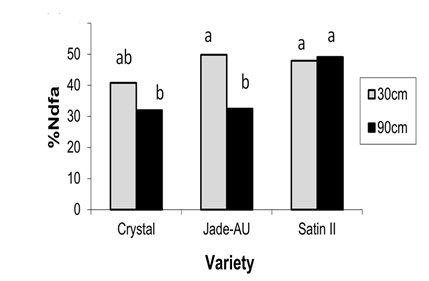
Figure 10. %Ndfa of different varieties at 2 row spacings, Kingaroy 2012/13
Soybeans
Row spacing and population trials
The first soybean trial was established in the 2013/14 seasons and again in 2014/15. The initial trials were based on a population trials with 3 varieties (Soy791, Richmond, Hayman), planted at 10, 20, 30 and 40 plant/m2, on 50cm rows with 3 reps of each. Row spacing trials were planted with a target population of 25plants/m2. The row spacing treatments were 25, 50, 75 and 100cm
In the first season 1 site was planted at Kingsthorpe on the Darling Downs. In the season just gone 2 sites were planted at Warwick and Wooroolin (South Burnett). Only the 2013/14 results were available at the time of writing.
The yields were far from expected in a dryland situation on the Darling Downs due to the weather conditions. The highest yielding variety in the row spacing trial was Soy791, almost 500kg/ha behind was Richmond followed by Hayman – Hayman’s yield may have been reduced by not reaching full maturity due to it being a longer season type. This trend was not as evident in the biomass cuts with no significant differences between the varieties, however Soy791 TDM was 6,303 kg/ha vs Hayman and Richmond 5,387 and 5,550 kg/ha respectively (LSD 1,426kg).
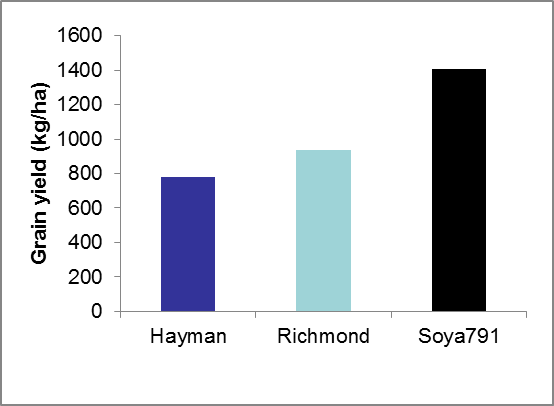
LSD 5% 240
Figure 11. Kingsthorpe soybean variety yields 2013/14
There is a distinct trend for grain yield to improve as you reduce row spacings with 25cm treatment yield significantly higher than all other treatments (Figure 5.5). In a season with limited rainfall this goes against the perceived benefit of planting on wider rows to conserve moisture for later in the growing season, further testing of this in dryland situations to confirm or deny will certainly help the industry to improve yields.
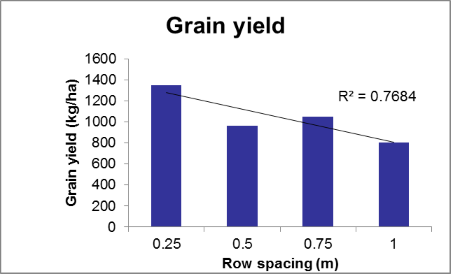
LSD 5% 284.8
Figure 12. Row spacing treatment effect on soybeans at Kingsthorpe
Soy791 was the best performer across most treatments with the exception of 1.0m row spacing where Richmond provided the highest yield. All varieties produced their best yield with the 25cm treatment; however it was not necessarily statistically different.
The harvest index of this trial was quite poor with a site average of 0.186. There are several reasons for this:
- Early bulk of growth with reduced seed set due to drought effect
- Very low pod set with a 7-10% estimate of grain left in the paddock with mechanical harvest
- Crop not fully maturing and not converting assimilates into grain with leaf still on the crop at desiccation.
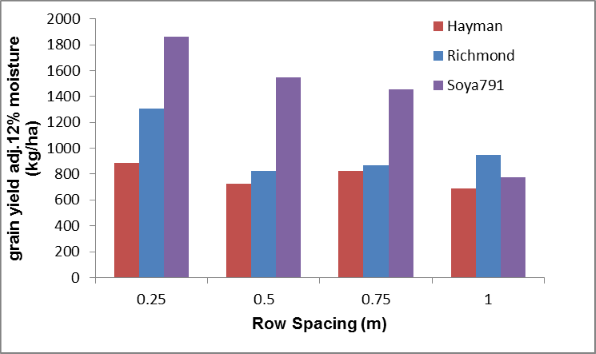
Figure 13. Effect of row spacing on yields of 3 soybean varieties at Kingsthorpe 2013/14
(kg/ha) (LSD 5% 458.4)
Summary and conclusions
With both summer pulses yields can be improved by planting at narrower row spacings. This has been evident in mungbeans in both a below average and above average seasons. The reasons are not fully understood but are suspected to relate to root morphology and how they explore the soil volume for water and also the larger crop canopy on narrow row spacings intercepting more of the light energy.
Populations are not as important in determining yields and the current industries recommendations should remain as the target populations. The fact that lower populations are not reducing yields significantly may help in making replanting decisions when establishment is effected by other factors.
Both of these factors and their effect on maximising yields in varied climates, along with improved varieties, will lead to greater confidence in the ability to grow a profitable crop and make mungbeans and soybeans viable crop options in the farming enterprise and not just break crops for the cereal dominated systems.
Acknowledgements
The research undertaken as part of this project is made possible by the significant contributions of growers through both trial cooperation and the support of the GRDC, the author would like to thank them for their continued support.
The Queensland Pulse Agronomy group would also like to extend their appreciation to the trial co-operators who have hosted our trials; Wade Bidstrup, Glenn Milne, Tom Woods and family, Ben Moloney, Andrew Lester and John Champney.
Contact details
Kerry McKenzie
Department of Agriculture and Fisheries Queensland
203 Tor St, Toowoomba
Ph: 0477 723 713
Email: kerry.mckenzie@daf.qld.gov.au
GRDC Project Code: UQ00067,
Was this page helpful?
YOUR FEEDBACK
